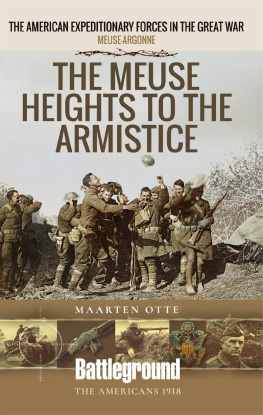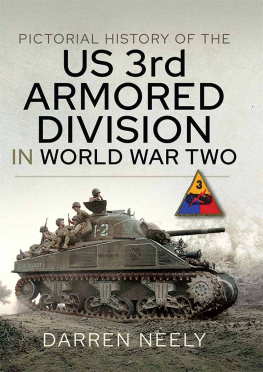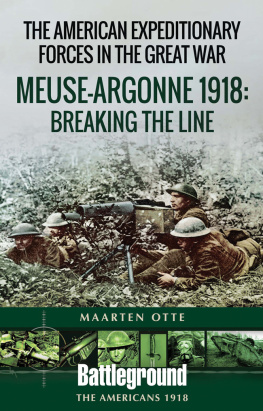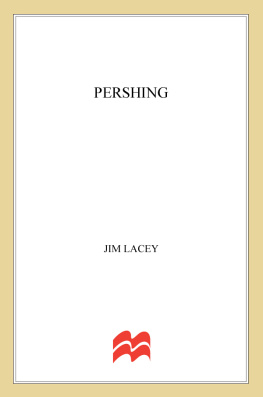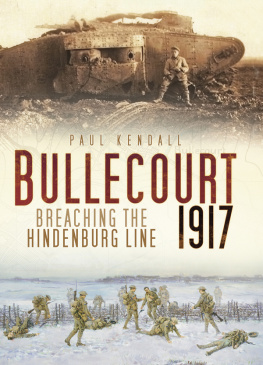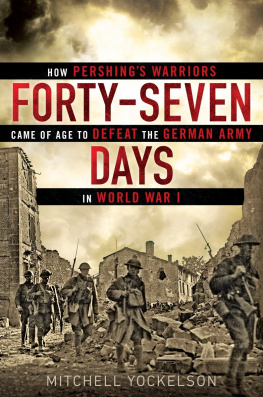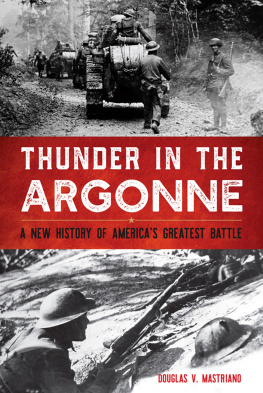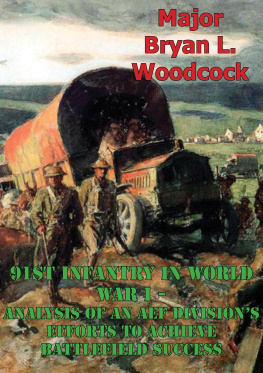
Dedicated to the memory of Sergeant Oscar Lubchansky (later, Lobe) 18961958
Company G, 313th Infantry Regiment, 79th Division, American Expeditionary Forces
It seems to me proven that the Infantry of the 79th Division attacked the strong German machine gun positions with very little artillery support, and to this fact is due its disorganization and failure to take its objectives.... To recapitulate, the infantry of the 79th Division attempted to capture the German positions with their bare hands.
Colonel C.F. Crain, 79th Division Field Notes, May 16, 1919
First published in Great Britain in 2017 by Osprey Publishing,
PO Box 883, Oxford, OX1 9PL, UK
1385 Broadway, 5th Floor, New York, NY 10018, USA
E-mail:
This electronic edition published in 2017 by Bloomsbury Publishing Plc
Osprey Publishing, part of Bloomsbury Publishing Plc
OSPREY is a trademark of Osprey Publishing, a division of Bloomsbury Publishing Plc
2017 Gene Fax
All rights reserved
You may not copy, distribute, transmit, reproduce or otherwise make available this publication (or any part of it) in any form, or by any means (including without limitation electronic, digital, optical, mechanical, photocopying, printing, recording or otherwise), without the prior written permission of the publisher. Any person who does any unauthorised act in relation to this publication may be liable to criminal prosecution and civil claims for damages.
Every attempt has been made by the Publisher to secure the appropriate permissions for material reproduced in this book. If there has been any oversight we will be happy to rectify the situation and written submission should be made to the Publisher.
A CIP catalog record for this book is available from the British Library.
Gene Fax has asserted his right under the Copyright, Designs and Patents Act, 1988, to be identified as the Author of this Work.
ISBN: 978-1-4728-1923-9 (HB)
ISBN: 978-1-4728-1925-3 (eBook)
ISBN: 978-1-4728-1924-6 (ePDF)
Maps drawn by Dan Mooney, Harwich Port, MA, based on originals from the American Battlefield
Monuments Commission.
Quoted materials from Donald Smythe, Pershing: General of the Armies (Indiana University Press, 1986) reprinted with permission of Indiana University Press.
Osprey Publishing supports the Woodland Trust, the UKs leading woodland conservation charity.
Between 2014 and 2018 our donations are being spent on their Centenary Woods project in the UK.
To find out more about our authors and books visit www.ospreypublishing.com. Here you will find our full range of publications, as well as exclusive online content, details of forthcoming events and the option to sign up for our newsletters. You can also sign up for Osprey membership, which entitles you to a discount on purchases made through the Osprey site and access to our extensive online image archive.
Front Cover: Company G, 313th Infantry, in the Troyon sector. (AHEC)
Translation of Hebrew verse on final page: This book is complete and done, Praise to God the
Eternal Lord. And with gratitude to my parents, my teachers and my wife; I am Elyakim Getzel ben David Tzvi.
The following will help in converting measurements:
| 1 mile=1.61km | 1 inch=2.54cm |
| 1 yard=0.91m | 1 US ton=0.91 metric tonnes |
| 1 foot=30.48cm | 1lb=0.45kg |
CONTENTS
ACKNOWLEDGEMENTS
Friends, family, historians, librarians, and archivists have been unfailingly helpful and encouraging throughout the twenty-year process of writing this book. Christina Holstein, Shreedhar Kanetkar, Neil Grauer, John Claussen, Teo Dagi, David Diamond, Philip Fishman, and my brother Chuck read all or portions of the book and offered valuable comments and criticism. Chuck, Ingrid Ferrand, and Rob de Soete walked the battlefield with me. Robert Ferrell, professor of history emeritus at Indiana University; Douglas V. Johnson II, formerly of the US Army War College; and Jonathan Sarna, professor of history at Brandeis University gave of their knowledge and enthusiasm. I owe a special debt to Brigadier General (ret.) Robert A. Doughty, formerly of the US Military Academy, who introduced me to then-Lieutenant Colonel Frdric Guelton of the Service Historique de lArme de Terre (now the Service Historique de la Dfense). Colonel Guelton in turn gave me access to the files of that formidable institution. Other archivists who helped me unstintingly were Richard J. Sommers and David Keogh of the Military History Institute (now the US Army Heritage and Education Center); Susan Lintelmann of the US Military Academy; Tim Nenninger and Mitchell Yockelson of the National Archives and Records Administration at College Park; and the indefatigable staff of the NARA reading room. Mitch, Robert Doughty, and Dennis Showalter, professor of history at Colorado College read the manuscript, for which much thanks. Emmanuel Dumas obtained from the Bibliothque de Documentation Internationale Contemporaine relevant portions of the histories of over twenty German regiments; Julie Allen and Neil Berkowitz translated the blackletter text into English. The research staff of the Newton (Massachusetts) Free Library never failed to locate a document I requested, however obscure. Others who supplied me with materials were the late Hannah Zeidlik, who told me the whereabouts of General Kuhns papers, and Betty K. Boothe, who sent me materials on Tenney Ross, her great-great-uncle. Therry Schwartz, the late Len Shurtleff of the Western Front Association, and the late Sydney Wise of Carleton University inspired me early in the process. The book has benefited immensely from the scrutiny of my agent, Leila Campoli of Stonesong, and of Kate Moore and Laura Callaghan of Osprey Publishing. Errors of fact or judgment are my own. My great appreciation goes as well to the 3M Company, inventors of Post-It Notes; how were books written before they existed?
Finally, I cannot thank enough my wife Ruth, who inspired me to undertake this project in the first place, who read several versions of the manuscript, and whose love and patienceand occasional impatiencewere crucial to its completion.
MAPS

NOTES FROM THE AUTHOR
Times
From September 16, 1918, through October 5, French and German clocks showed the same time. From October 6 through November 11, German clocks were ahead by one hour; i.e., when French clocks showed noon, German clocks showed 1:00 p.m. Times herein have been adjusted where necessary to conform to French clocks.
In World War I the United States Army had not yet standardized its notation for clock time. A given time might be recorded in war diaries, field messages, and operations reports as 6:15 p.m., 18 H 15, 18:15, or variations on all of them. To accommodate the lay reader, this work expresses times (except in direct quotations) using the conventional 12-hour clock.
Distances
The AEF used both English and metric units in designating distances. I use English units (yards, miles) for distances over the ground, such as the width of a front or the depth of an advance. I use metric units (meters, kilometers) for distances that are specified in orders, such as artillery firing ranges or intervals between units, or that are contained in direct quotes.



